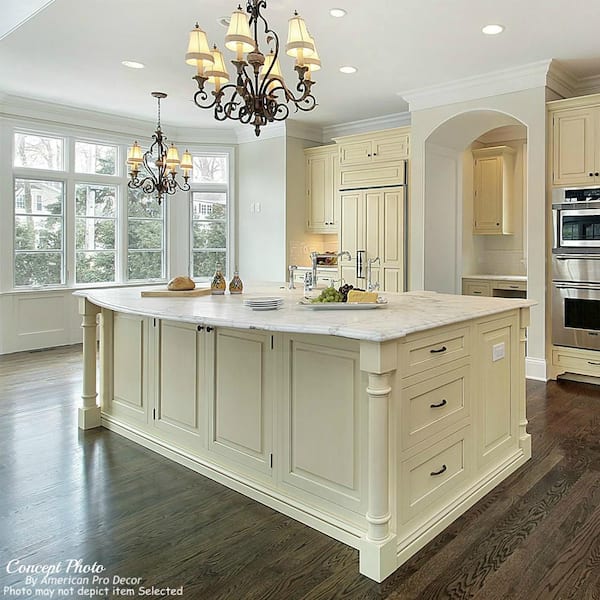Include Beauty and Character to Your Room with Legs For Kitchen Island Creations
An Overview to Choosing the Perfect Legs For Kitchen Island for Your Home
Picking the ideal legs for your kitchen area island is a nuanced choice that affects both the capability and aesthetic appeal of this central area. As you consider these elements, it comes to be obvious that the right legs can transform not just the appearance of your kitchen area yet also its use for years to come.

Comprehending Kitchen Area Island Legs
When selecting legs for a kitchen island, it's vital to recognize their visual and functional functions in the general design. The legs work as a crucial support group, making sure security and toughness for the island, which often operates as an office, dining location, or gathering spot. For that reason, the choice of material and construction method must be durable adequate to withstand day-to-day usage and prospective wear.
In enhancement to their structural duties, legs contribute considerably to the island's aesthetic appeal. They can boost the cooking area's style, whether through typical, modern, or diverse designs. The height and percentage of the legs are also important factors to consider; they need to balance with the island's kitchen counter elevation while making sure comfortable seating for those using the room.
Furthermore, the leg design can affect the general circulation of the kitchen area. Open, ventilated leg styles can create a feeling of agility, while strong, significant legs might share an extra based and secure aesthetic - Legs For Kitchen Island. Comprehending these useful and visual facets will certainly guide property owners in making notified choices that enhance their kitchen area's style and boost its use
Popular Styles and Materials
The selection of legs for a kitchen island includes a range of prominent designs and materials, each offering unique qualities that can enhance both performance and looks. Typical legs normally exhibit ornate information and workmanship, improving traditional kitchen area layouts.

Height and Stability Factors To Consider

Stability is one more vital factor to consider. The legs of the cooking area island ought to offer ample assistance, ensuring that the structure can hold up against daily usage without changing or tottering. Product option plays a substantial duty in stability; metal legs, for circumstances, have a tendency to provide greater strength contrasted to timber. Additionally, making sure that the island is safely secured to the floor or wall surface can enhance stability, specifically for bigger islands that may bear considerable weight.
Matching Your Kitchen Aesthetic
Choosing the best legs for your cooking area island goes past capability; it additionally plays a significant function in the general visual of the space. When choosing legs, take into consideration the design style of your kitchen area. For a contemporary look, smooth metal or minimalist designs can develop a tidy, contemporary vibe. On the various other hand, conventional or rustic kitchen areas usually gain from wooden legs with intricate detailing or a distressed coating, improving heat and personality.
Shade is another crucial factor. Legs that complement or comparison with your island's surface and bordering cabinetry can develop visual harmony or striking prime focus. Matching dark wood legs with a light marble counter top can include depth and rate of interest. Furthermore, think about the finish of the legs; matte, shiny, or distinctive finishes can substantially impact the general feel of the kitchen area.
Setup and Maintenance Tips
Installing cooking area island legs calls for mindful focus to detail to make sure both stability and visual allure. Make use of a stud finder to situate wall studs if you are attaching the legs to a wall surface or utilizing braces for added support.
When safeguarding the legs, make use of high-grade screws and, if essential, wood glue for additional toughness. For metal legs, make certain that you are utilizing suitable anchors and tools to stop damages to your floor covering. It is a good idea to check for levelness after installation, making modifications as needed to stay clear of wobbling.
Maintenance is just as essential for durability - Legs For Kitchen Island. Routinely examine the legs for any indications of wear or loosening, specifically in high-traffic areas. Clean the legs with a suitable cleaner, avoiding abrasive products that may scratch the surface area. For wood legs, think about using a wood conditioner periodically to maintain their coating. By adhering visit to these installment and upkeep suggestions, you can make certain that your cooking area island legs remain both functional and aesthetically enticing.
Verdict
Finally, picking the appropriate legs for a kitchen island requires cautious consideration of height, security, and aesthetic compatibility. By picking appropriate products and styles that line up with the total kitchen design, performance can be enhanced while maintaining visual allure. Correct installment and recurring upkeep even more contribute to the longevity and long life of the kitchen island. Ultimately, thoughtful leg option plays a crucial role in boosting both the practicality and design of the kitchen area.
When selecting legs for a cooking area island, it's vital to recognize their visual and practical duties in the general style. Open, airy leg designs can develop a feeling of agility, while solid, considerable legs may communicate Continued a more grounded and stable aesthetic. The legs of the cooking area island need to provide appropriate assistance, making certain that the framework can hold up against everyday usage without wobbling or moving.Setting up cooking area island legs needs careful interest to detail to ensure both stability and aesthetic appeal.In conclusion, choosing the suitable legs for a kitchen island demands cautious consideration of elevation, security, and aesthetic compatibility.